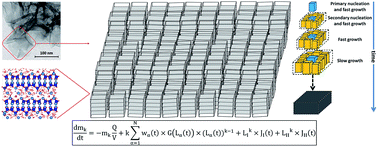当前位置:
X-MOL 学术
›
J. Mater. Chem. A
›
论文详情
Our official English website, www.x-mol.net, welcomes your
feedback! (Note: you will need to create a separate account there.)
On the mesoscale mechanism of synthetic calcium–silicate–hydrate precipitation: a population balance modeling approach
Journal of Materials Chemistry A ( IF 10.7 ) Pub Date : 2017-11-06 00:00:00 , DOI: 10.1039/c7ta08784e M. Reza Andalibi 1, 2, 3, 4, 5 , Abhishek Kumar 3, 4, 5, 6, 7 , Bhuvanesh Srinivasan 3, 4, 5, 6, 7 , Paul Bowen 3, 4, 5, 6, 7 , Karen Scrivener 3, 6, 7, 8 , Christian Ludwig 1, 2, 3, 6, 9 , Andrea Testino 1, 2, 3
Journal of Materials Chemistry A ( IF 10.7 ) Pub Date : 2017-11-06 00:00:00 , DOI: 10.1039/c7ta08784e M. Reza Andalibi 1, 2, 3, 4, 5 , Abhishek Kumar 3, 4, 5, 6, 7 , Bhuvanesh Srinivasan 3, 4, 5, 6, 7 , Paul Bowen 3, 4, 5, 6, 7 , Karen Scrivener 3, 6, 7, 8 , Christian Ludwig 1, 2, 3, 6, 9 , Andrea Testino 1, 2, 3
Affiliation

|
Calcium–silicate–hydrate (C–S–H) is the most important product of cement hydration. Despite this importance, its formation mechanism is not well-understood. Here, we describe the novel application of a coupled thermodynamic-kinetic computational model based on a population balance equation in order to unravel the overall mechanism of synthetic C–S–H precipitation. The framework, embracing primary nucleation, true secondary nucleation, and molecular growth as the constituting sub-processes, is regressed to experimental Ca2+(aq) concentration vs. time data collected on a model synthetic C–S–H with Ca : Si = 2. Upon the critical appraisal of the model's adjustable parameters, which turn out to adopt rational values, simulations were performed to estimate various characteristics of the aforementioned model system (e.g., the kinetic speciation during the precipitation process, or the mechanisms and activation free energies of nucleation and growth phenomena). We mechanistically account for the evolution of the C–S–H mesostructure which is made up of defective crystallites around 3–6 nm thick, nematically packing together in two dimensions giving rise to foil-like polycrystalline particles around 100 nm in breadth, close to the experimentally observed values. The computational framework is generic and can be applied to other precipitation systems and cement hydration scenarios.
中文翻译:

关于合成钙硅酸盐水合物沉淀的中尺度机理:人口平衡建模方法
硅酸钙水合物(C–S–H)是水泥水合的最重要产物。尽管具有如此重要的意义,但其形成机制仍未得到很好的理解。在这里,我们描述了一种基于种群平衡方程的热力学-动力学耦合计算模型的新颖应用,以揭示合成的C–S–H降水的整体机理。框架包含初级成核,真正的次级成核和分子生长作为构成子过程,回归到实验Ca 2+(aq)浓度对。在模型合成C–H–H上收集的时间数据,其中Ca:Si =2。在对该模型的可调参数进行严格评估后,结果证明采用合理值,进行了仿真以评估上述模型系统的各种特征(例如,沉淀过程中的动力学形态或成核和生长现象的机理和活化自由能)。我们用机械的方式解释了C–S–H介观结构的演化,该结构由约3–6 nm厚的有缺陷的微晶组成,二维向列堆积在一起,从而产生了宽度约为100 nm的箔状多晶颗粒,接近于实验观察到的值。计算框架是通用的,可以应用于其他降水系统和水泥水化方案。
更新日期:2017-11-16
中文翻译:

关于合成钙硅酸盐水合物沉淀的中尺度机理:人口平衡建模方法
硅酸钙水合物(C–S–H)是水泥水合的最重要产物。尽管具有如此重要的意义,但其形成机制仍未得到很好的理解。在这里,我们描述了一种基于种群平衡方程的热力学-动力学耦合计算模型的新颖应用,以揭示合成的C–S–H降水的整体机理。框架包含初级成核,真正的次级成核和分子生长作为构成子过程,回归到实验Ca 2+(aq)浓度对。在模型合成C–H–H上收集的时间数据,其中Ca:Si =2。在对该模型的可调参数进行严格评估后,结果证明采用合理值,进行了仿真以评估上述模型系统的各种特征(例如,沉淀过程中的动力学形态或成核和生长现象的机理和活化自由能)。我们用机械的方式解释了C–S–H介观结构的演化,该结构由约3–6 nm厚的有缺陷的微晶组成,二维向列堆积在一起,从而产生了宽度约为100 nm的箔状多晶颗粒,接近于实验观察到的值。计算框架是通用的,可以应用于其他降水系统和水泥水化方案。











































 京公网安备 11010802027423号
京公网安备 11010802027423号